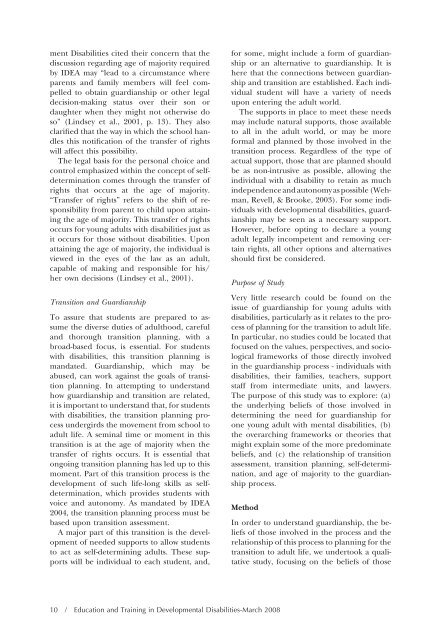Download the Journal (PDF) - Division on Autism and ...
Download the Journal (PDF) - Division on Autism and ...
Download the Journal (PDF) - Division on Autism and ...
Create successful ePaper yourself
Turn your PDF publications into a flip-book with our unique Google optimized e-Paper software.
ment Disabilities cited <str<strong>on</strong>g>the</str<strong>on</strong>g>ir c<strong>on</strong>cern that <str<strong>on</strong>g>the</str<strong>on</strong>g><br />
discussi<strong>on</strong> regarding age of majority required<br />
by IDEA may “lead to a circumstance where<br />
parents <strong>and</strong> family members will feel compelled<br />
to obtain guardianship or o<str<strong>on</strong>g>the</str<strong>on</strong>g>r legal<br />
decisi<strong>on</strong>-making status over <str<strong>on</strong>g>the</str<strong>on</strong>g>ir s<strong>on</strong> or<br />
daughter when <str<strong>on</strong>g>the</str<strong>on</strong>g>y might not o<str<strong>on</strong>g>the</str<strong>on</strong>g>rwise do<br />
so” (Lindsey et al., 2001, p. 13). They also<br />
clarified that <str<strong>on</strong>g>the</str<strong>on</strong>g> way in which <str<strong>on</strong>g>the</str<strong>on</strong>g> school h<strong>and</strong>les<br />
this notificati<strong>on</strong> of <str<strong>on</strong>g>the</str<strong>on</strong>g> transfer of rights<br />
will affect this possibility.<br />
The legal basis for <str<strong>on</strong>g>the</str<strong>on</strong>g> pers<strong>on</strong>al choice <strong>and</strong><br />
c<strong>on</strong>trol emphasized within <str<strong>on</strong>g>the</str<strong>on</strong>g> c<strong>on</strong>cept of selfdeterminati<strong>on</strong><br />
comes through <str<strong>on</strong>g>the</str<strong>on</strong>g> transfer of<br />
rights that occurs at <str<strong>on</strong>g>the</str<strong>on</strong>g> age of majority.<br />
“Transfer of rights” refers to <str<strong>on</strong>g>the</str<strong>on</strong>g> shift of resp<strong>on</strong>sibility<br />
from parent to child up<strong>on</strong> attaining<br />
<str<strong>on</strong>g>the</str<strong>on</strong>g> age of majority. This transfer of rights<br />
occurs for young adults with disabilities just as<br />
it occurs for those without disabilities. Up<strong>on</strong><br />
attaining <str<strong>on</strong>g>the</str<strong>on</strong>g> age of majority, <str<strong>on</strong>g>the</str<strong>on</strong>g> individual is<br />
viewed in <str<strong>on</strong>g>the</str<strong>on</strong>g> eyes of <str<strong>on</strong>g>the</str<strong>on</strong>g> law as an adult,<br />
capable of making <strong>and</strong> resp<strong>on</strong>sible for his/<br />
her own decisi<strong>on</strong>s (Lindsey et al., 2001).<br />
Transiti<strong>on</strong> <strong>and</strong> Guardianship<br />
To assure that students are prepared to assume<br />
<str<strong>on</strong>g>the</str<strong>on</strong>g> diverse duties of adulthood, careful<br />
<strong>and</strong> thorough transiti<strong>on</strong> planning, with a<br />
broad-based focus, is essential. For students<br />
with disabilities, this transiti<strong>on</strong> planning is<br />
m<strong>and</strong>ated. Guardianship, which may be<br />
abused, can work against <str<strong>on</strong>g>the</str<strong>on</strong>g> goals of transiti<strong>on</strong><br />
planning. In attempting to underst<strong>and</strong><br />
how guardianship <strong>and</strong> transiti<strong>on</strong> are related,<br />
it is important to underst<strong>and</strong> that, for students<br />
with disabilities, <str<strong>on</strong>g>the</str<strong>on</strong>g> transiti<strong>on</strong> planning process<br />
undergirds <str<strong>on</strong>g>the</str<strong>on</strong>g> movement from school to<br />
adult life. A seminal time or moment in this<br />
transiti<strong>on</strong> is at <str<strong>on</strong>g>the</str<strong>on</strong>g> age of majority when <str<strong>on</strong>g>the</str<strong>on</strong>g><br />
transfer of rights occurs. It is essential that<br />
<strong>on</strong>going transiti<strong>on</strong> planning has led up to this<br />
moment. Part of this transiti<strong>on</strong> process is <str<strong>on</strong>g>the</str<strong>on</strong>g><br />
development of such life-l<strong>on</strong>g skills as selfdeterminati<strong>on</strong>,<br />
which provides students with<br />
voice <strong>and</strong> aut<strong>on</strong>omy. As m<strong>and</strong>ated by IDEA<br />
2004, <str<strong>on</strong>g>the</str<strong>on</strong>g> transiti<strong>on</strong> planning process must be<br />
based up<strong>on</strong> transiti<strong>on</strong> assessment.<br />
A major part of this transiti<strong>on</strong> is <str<strong>on</strong>g>the</str<strong>on</strong>g> development<br />
of needed supports to allow students<br />
to act as self-determining adults. These supports<br />
will be individual to each student, <strong>and</strong>,<br />
for some, might include a form of guardianship<br />
or an alternative to guardianship. It is<br />
here that <str<strong>on</strong>g>the</str<strong>on</strong>g> c<strong>on</strong>necti<strong>on</strong>s between guardianship<br />
<strong>and</strong> transiti<strong>on</strong> are established. Each individual<br />
student will have a variety of needs<br />
up<strong>on</strong> entering <str<strong>on</strong>g>the</str<strong>on</strong>g> adult world.<br />
The supports in place to meet <str<strong>on</strong>g>the</str<strong>on</strong>g>se needs<br />
may include natural supports, those available<br />
to all in <str<strong>on</strong>g>the</str<strong>on</strong>g> adult world, or may be more<br />
formal <strong>and</strong> planned by those involved in <str<strong>on</strong>g>the</str<strong>on</strong>g><br />
transiti<strong>on</strong> process. Regardless of <str<strong>on</strong>g>the</str<strong>on</strong>g> type of<br />
actual support, those that are planned should<br />
be as n<strong>on</strong>-intrusive as possible, allowing <str<strong>on</strong>g>the</str<strong>on</strong>g><br />
individual with a disability to retain as much<br />
independence <strong>and</strong> aut<strong>on</strong>omy as possible (Wehman,<br />
Revell, & Brooke, 2003). For some individuals<br />
with developmental disabilities, guardianship<br />
may be seen as a necessary support.<br />
However, before opting to declare a young<br />
adult legally incompetent <strong>and</strong> removing certain<br />
rights, all o<str<strong>on</strong>g>the</str<strong>on</strong>g>r opti<strong>on</strong>s <strong>and</strong> alternatives<br />
should first be c<strong>on</strong>sidered.<br />
Purpose of Study<br />
Very little research could be found <strong>on</strong> <str<strong>on</strong>g>the</str<strong>on</strong>g><br />
issue of guardianship for young adults with<br />
disabilities, particularly as it relates to <str<strong>on</strong>g>the</str<strong>on</strong>g> process<br />
of planning for <str<strong>on</strong>g>the</str<strong>on</strong>g> transiti<strong>on</strong> to adult life.<br />
In particular, no studies could be located that<br />
focused <strong>on</strong> <str<strong>on</strong>g>the</str<strong>on</strong>g> values, perspectives, <strong>and</strong> sociological<br />
frameworks of those directly involved<br />
in <str<strong>on</strong>g>the</str<strong>on</strong>g> guardianship process - individuals with<br />
disabilities, <str<strong>on</strong>g>the</str<strong>on</strong>g>ir families, teachers, support<br />
staff from intermediate units, <strong>and</strong> lawyers.<br />
The purpose of this study was to explore: (a)<br />
<str<strong>on</strong>g>the</str<strong>on</strong>g> underlying beliefs of those involved in<br />
determining <str<strong>on</strong>g>the</str<strong>on</strong>g> need for guardianship for<br />
<strong>on</strong>e young adult with mental disabilities, (b)<br />
<str<strong>on</strong>g>the</str<strong>on</strong>g> overarching frameworks or <str<strong>on</strong>g>the</str<strong>on</strong>g>ories that<br />
might explain some of <str<strong>on</strong>g>the</str<strong>on</strong>g> more predominate<br />
beliefs, <strong>and</strong> (c) <str<strong>on</strong>g>the</str<strong>on</strong>g> relati<strong>on</strong>ship of transiti<strong>on</strong><br />
assessment, transiti<strong>on</strong> planning, self-determinati<strong>on</strong>,<br />
<strong>and</strong> age of majority to <str<strong>on</strong>g>the</str<strong>on</strong>g> guardianship<br />
process.<br />
Method<br />
10 / Educati<strong>on</strong> <strong>and</strong> Training in Developmental Disabilities-March 2008<br />
In order to underst<strong>and</strong> guardianship, <str<strong>on</strong>g>the</str<strong>on</strong>g> beliefs<br />
of those involved in <str<strong>on</strong>g>the</str<strong>on</strong>g> process <strong>and</strong> <str<strong>on</strong>g>the</str<strong>on</strong>g><br />
relati<strong>on</strong>ship of this process to planning for <str<strong>on</strong>g>the</str<strong>on</strong>g><br />
transiti<strong>on</strong> to adult life, we undertook a qualitative<br />
study, focusing <strong>on</strong> <str<strong>on</strong>g>the</str<strong>on</strong>g> beliefs of those
















